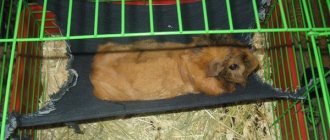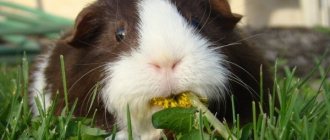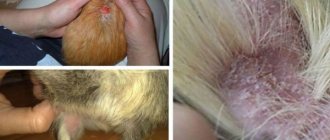How and in what poses
The guinea pig is a pack animal. In its natural habitat, it is surrounded by strong predators; it is forced to hide in burrows, look for food, relying on the protection of adult males. The constant subconscious expectation of an attack naturally influenced the animal’s lifestyle, which is followed by pets.
When adapting to a new place of residence, a rodent may not sleep for several days. This is a completely natural reaction of a rodent to an unfamiliar environment, smells, frightening sounds, etc. From the new environment, the rodent becomes stressed and tries to hide in a shelter, in the darkest corner.
During the first days of getting used to new living conditions, the animal should not be disturbed without reason. You must add water and add food carefully, without making sudden movements, while at the same time affectionately addressing your pet by name.
The length of your guinea pig's sleep will gradually return to normal. Usually a calm animal falls asleep gradually. At the initial stage, the animal sits on its hind legs, slowly relaxes and lies down on the floor. However, at first, pigs are still wary of their owner, as evidenced by quivering ears and wide open eyes. The animal will be able to fall asleep only after completely calming down.
The more a pet gets used to a new place, the more fun it becomes and the more relaxed it feels. In everyday life, sleeping pigs take the following positions:
- lying on your side, with your paws tucked close to your body (or, alternatively, stretched out along the body), with your eyes closed;
- on the back;
- on the belly.
But the position when a guinea pig sleeps with its eyes open means excessive concern. If your pig is often found in uncomfortable positions, this is a reason to consult a veterinarian. This may be caused by the pet being unwell, or by some hidden injury.
When a guinea pig sleeps, it happens that it twitches its paws. Maybe she's having troubled dreams. To calm the animal, you need to slowly cover its nose with your palm. The familiar smell of a beloved owner will undoubtedly calm the pet.
When to contact a veterinarian
By carefully observing the animal, you can determine its condition and notice the onset of diseases in time. Sometimes the reasons for overexcitement of a rodent inside the home are so serious that it is impossible to do without the intervention of a doctor.
An alarming sign is the animal running and stopping to gnaw at the bars of the cage. This behavior indicates serious dental problems. In this case, contacting a doctor is mandatory.
It’s even worse if the animal is lethargic but restless. For example, when a guinea pig lies on its side, twitching its paws and head, this is a reason to be seriously alarmed. With this behavior of the animal, there is a high chance of contracting helminthiasis or gastrointestinal pathology. The rodent should be taken to the vet immediately.
It happens that a guinea pig jumps and twitches because it is bothered by itchy skin. The cause of the disease is lice-eating parasites. When examining the fur, skin redness and peeling may be detected. If no measures are taken, wounds will form in these areas. The sooner the animal gets to the veterinarian and begins treatment, the shorter the entire period of getting rid of parasites will be.
When buying a guinea pig, you need to find out how often the previous owners worked with the animal, what they taught it. Then it will be easier to draw conclusions about the reasons for changes in the pet’s behavior.
It is normal for most of these rodents to express their joy through popcorning, and this occurs in all known breeds. Therefore, if your pet is healthy, he has enough movement and jumps up, just be happy.
Schedule
Guinea pigs are very active diurnal animals. These are quite nimble animals, despite their corpulent dimensions and impressive shape. The sleep period is short-term and lasts about 8–10 minutes. The total amount of sleep per day lasts about 4–6 hours.
Basically, the daily routine of rodents is quite consistent with the standard human one. During the day there is quite business activity, and at night it is time for sleep and rest. A characteristic feature of pigs is that they eat in small portions, but quite often. A pig can go to the bowl about 80 times a day. So the animal is characterized by noisy night feasts, which can disturb household members from sleeping.
In turn, the pig itself sleeps extremely lightly. Therefore, you should not disturb her before bed with loud noises, etc.
It happens that the animals’ daily routine changes, the period of sleep and wakefulness shifts. It’s not scary; it’s easy to correct your pet’s behavior if you shift the meal time. However, this must be done very carefully, since fluffies are very sensitive to any changes.
How a rodent became a pig
These cute rodents come from the mountainous region of South America, from Peru, Bolivia, Ecuador and southern Colombia. The harsh conditions of the Central Andes have long been inhabited by many different representatives of the pig family, and, as genetic studies have shown, about 5 thousand years ago, local residents decided to breed rodents for their needs. And after several thousand years, figurines of guinea pigs appeared.
Hundreds of years have passed, and with the help of targeted selection, species of guinea pigs were bred that differed from their wild relatives in their greater mass and decorative appearance. Basically, the Indians ate domesticated rodents for food or used them in sacrifices and fortune telling by their entrails.
At the same time, it was important that domesticated guinea pigs were presented to the gods as gifts, since, according to local beliefs, only what was obtained through hard work should be donated to the deity
The first Europeans to learn about animals unknown in the Old World were the Spaniards. From numerous local tribes, conquistadors and missionaries received information about funny rodents like rats or rabbits, which the natives bred as meat breeds. To the conquerors who tasted the exotic meat, its taste was reminiscent of suckling pig. Perhaps this is why in Europe they began to call overseas animals pigs.
Another possible reason is that guinea pigs make funny sounds that resemble the grunts and squeals of a pig. They also constantly chew something, like real pigs. This is due to the peculiarities of the digestive system, due to which babies have to eat greens often, but in small portions. The comparison turned out to be so successful that the word appears in most of the names of this species in various languages of the world.
In any case, in their historical homeland, guinea pigs are still a delicacy and a source of dietary meat, which in its taste is close to rabbit or chicken. In Peru alone, up to 65 million rodents are eaten annually.
We create comfortable conditions for your pet to sleep
Despite their relative unpretentiousness, pigs still need a comfortable living environment. They need bedding in the cage to sleep on, as well as houses and play tunnels to be able to hide. Comfortable conditions give pets the feeling of security they need.
When arranging a home for your furry friend, you should comply with some conditions:
- The cage should be located away from noisy household appliances, as well as from drafts and direct sunlight.
- The room temperature should be comfortable (18–23 °C).
- The minimum dimensions of a cage or terrarium for a pig are 30x40x50 cm.
- The cage must be cleaned several times a week.
- Play and exercise with your pet regularly.
Only in comfortable conditions will the pet feel at home, be able to fully relax and delight the owner with funny pranks.
Why do animals sleep curled up?
Probably the most common way of sleeping that a person knows is to curl up. As a rule, cats and dogs sleep this way. This way of sleeping allows these animals to retain more heat while relaxing their muscles and protecting the most important parts of their body. It is “written” into the animal’s instincts that such delicate parts, such as the belly, should be protected as much as possible, due to the fact that they are not covered by ribs or other bone tissue. Therefore, the back bones and spine are exposed.
Cats sleep curled up. This makes them feel safe.
And even cats and dogs that live at home, where no one threatens them, have not lost their memory of possible dangers, which are enshrined in the cortex of their brain and therefore remain cautious even in their sleep. The hearing and sense of smell of these animals work 24/7 in “on” mode.
And if a dog is sleeping at night, and someone outside the door pulls the doorknob, it will immediately start barking.
What time do rodents go to bed?
Guinea pigs sleep at night and are awake during the day. The pet's daily routine corresponds to the owner's routine. Pigs often go to sleep at the same time as their owner. But you still need to be prepared for the fact that the sleep phase of pigs is shorter than that of humans. Therefore, they wake up at night to go about their business, drink, eat, and maybe play.
The owner must be very attentive to the pet’s sleep and rest. When the animal is sleeping, but the owner is not, then you should mind your own business and walk around the apartment, making as little noise as possible - the pet wakes up from the slightest rustle.
It should be noted that pigs are very pedantic; they are comfortable living under conditions of a once and for all established schedule.
What a cell should be like: basic requirements
The most important thing is space. Your guinea pig should have room to run around and do its business. Pet stores offer a large selection of cages to help you decide.
The cage must have a lid. It is desirable that it be removable. This makes it easier to interact with your pet.
Guinea pigs have quite sensitive paws
For this reason, special attention should be paid to the pallet. The mesh bottom will not suit them
Give preference to a solid pallet that will resemble a regular floor. It can easily be covered with hay or other soil.
It is advisable that the pallet be removed. This makes cleaning the cage easier. This also needs to be done regularly.
Space and size
Immediately notice the large and spacious cells. Double-decker cages are more suitable for hamsters
As for guinea pigs, they will prefer vertical, spacious cages, which are usually purchased for rabbits.
By nature, guinea pigs move around quite a lot. When free, they have to walk kilometers to get food. It is for this reason that they need movement. Otherwise, the animal will suffer from obesity and other diseases.
It is advisable to keep these animals in comfortable home enclosures. If you have a private house, then make a small fence for the guinea pig on the site. This way she can run around on the grass.
The minimum size of a cage for one pig should be 60x40 cm. Try to let your guinea pig out of the cage every day so that it can run around more and be free.
Material of manufacture
The most common materials for making cages are metal, plastic and wood. Some people prefer to place the guinea pig in an aquarium.
Metal cages are the most durable. The rods are made of stainless steel, which are durable. Detergents also do not negatively affect quality.
The plastic tray is easy to clean. It is also resistant to all types of detergents. The main drawback is scratches.
Wooden cages are a poor solution. They quickly absorb moisture. For this reason, there may be an unpleasant odor that is almost impossible to remove. The sharp teeth of a guinea pig will soon render this dwelling unusable.
Design
First of all, a cage for a guinea pig should be spacious, comfortable and not dangerous. Only in this case will your pet feel good throughout its life.
The pallet must be well secured. In this case, it is convenient to move the cage to another place without the risk that it may fall apart and the animal will be injured.
The distance between the rods should be large. But it is worth considering the fact that the pig can easily stick its head in and get out. This cannot be allowed. For this reason, try to find the optimal size between the rods.
As for the location of the cage, it is better to choose a place that will be located on a hill. The fact is that guinea pigs are curious creatures. They love to watch everything that happens. The pet will also be calm if the owner is in sight.
Animal safety
When choosing housing for your pet, first of all, take care of safety.
Choose a cage so that the pallet is continuous. In this case, the pig is not at risk of injury to its paws, which are quite tender.
There are several types of cells
Sleep duration
So how long do guinea pigs sleep? This question is very interesting for novice owners. During the period of adaptation to a new place, the sleep patterns of animals can be very unique. Until the animal gets used to its new home and feels completely safe, it will try to sleep as little as possible.
Guinea pigs can rest fully only after making sure that nothing threatens them. The total duration of the animal's sleep periods is only 4–6 hours a day. It is noteworthy that the entire dream is divided into several parts. During the night, the animal falls asleep several times, the longest period of one-time rest is 15 minutes.
After being awake, the animals do not immediately fall asleep again. They can devote some time to their own business: eat, drink water, and the quickest ones can play.
Also watch the video of a guinea pig sleeping.
Simple but exciting toys
Entertaining a rodent is not difficult. Here are some examples of toys that will not let your pet get bored.
- Mirror. It is better to hang it outside, as the pig may get the idea to try the object on its tooth. The rodent will enjoy admiring and playing with its reflection, and will spend a lot of time doing this activity.
- Paper ball The rodent will love chasing crumpled paper balls, because they rustle so funny.
- Stuffed animals stuffed with hay. An old holey sock or a toilet paper tube can be used to make a stuffed animal. The animal will happily take dried grass out of it.
- Branches of fruit trees. Delicious twigs are a real treat for rodents.
- Balls. Small tennis balls and rubber bouncy balls will also work. The pet chases them with pleasure. The main thing is not to let her start gnawing on them.
- Cardboard box with holes. This is a real hit with rodents. Holes are made in the box for the animal to crawl through. The pig will be captivated by this maze for a long time.
- Wooden toys are a good option for sharpening your teeth. Wooden items must be made from natural wood, without paint or other toxic substances.
Do guinea pigs hibernate?
Guinea pigs are not hibernating mammals. The natural habitat of these rodents is warm southern countries, so the animals do not need to take shelter from the bitter cold. Only slightly reduced activity and the desire to warm up are echoes of the need for hibernation.
But a sudden prolonged sleep indicates some kind of disease in the animal and signals the need to consult a veterinarian.
Knowing the pet's sleep and rest habits, the owner is able to provide the pet with comfortable living conditions. No matter what concerns the owner may have, he must give his furry friend as much attention as possible. And then the animal will begin to completely trust you, will sleep on the owner’s lap, closing its eyes and completely entrusting its life to it, giving friendship for a long time.
Behavior and habits
Interesting facts about guinea pigs relate to the unusual behavior of rodents. Thus, animals are capable of making a variety of sounds. Each of them has its own meaning. For example, pregnant females can chirp like birds. Moreover, they prefer to do this at night, for 2-15 minutes.
During the mating season, males make purring sounds to attract the attention of the female. Squeaking signals hunger, and squealing indicates aggression.
Rodents sleep for only 10-15 minutes, but they do this up to 10 times a day! Animals are good at distinguishing colors. And a sleeping pet keeps its eyes slightly open so as not to miss danger.
During the day, rodents are more active, so at night their owners are rarely awakened by noise in the cage.
Reproduction and raising of young
Sexual maturity in wild guinea pigs occurs quickly. Males reach reproductive age at 2-3 months, and females are ready for procreation after 1 month of life. But the body of these rodents is fully formed before six months, so they mate no earlier than they are 5-6 months old.
Cavias can reproduce throughout the year, but often mate only in the warm season, when there is enough food around, which creates more favorable conditions for raising young animals.
In a clan of wild guinea pigs there is only one dominant male, and they do not have such concepts as mating games and battles for a female. The leader of the pack covers all his furry “wives”, who signal their readiness to become a mother in heat, leaving odorous marks for the male.
The baby will learn from his mother's experience of surviving in the wild
The general gestation period for guinea pigs is 2-2.5 months, and in one year females can give birth 3-4 times. There are from 1 to 8 cubs in one litter, their number depends on the age of the expectant mother. Young females give birth to 2-3 babies; the brood of more mature females can have from 4 to 8 offspring.
Newborn pigs are born well developed. Their eyes and ear canals are open, they have molars, and their entire body is covered with soft fur. The cubs grow very quickly, and already on the 3rd day of life they try juicy green grass for the first time, although they continue to feed on their mother’s milk for the next week.
Young pigs have only 4 weeks to learn how to get their own food, recognize the signals of their relatives, and distinguish the sounds and smells made by predators. Upon reaching 1 month, the cubs must leave their native clan and begin an independent life. Young cavys have to find their own territory and form a new family, and it is at this stage that most of the pigs die in the clutches of predatory animals.











